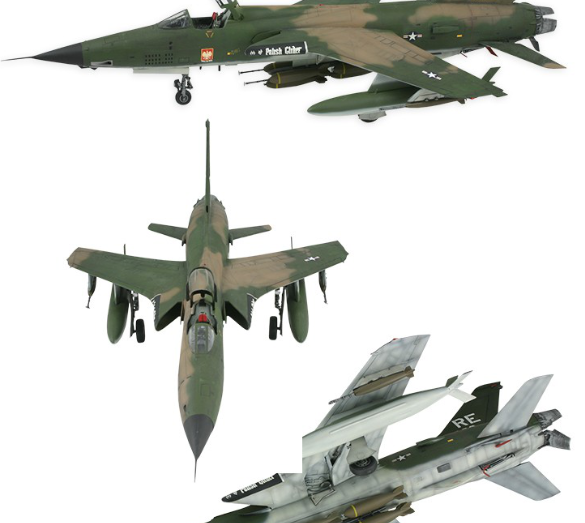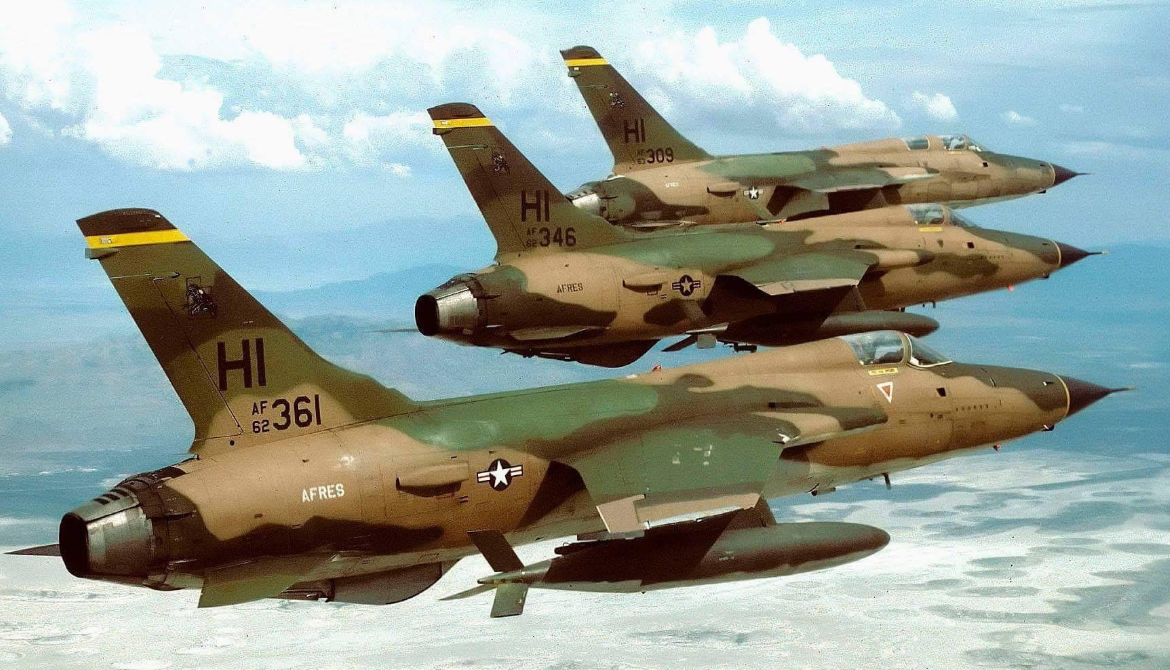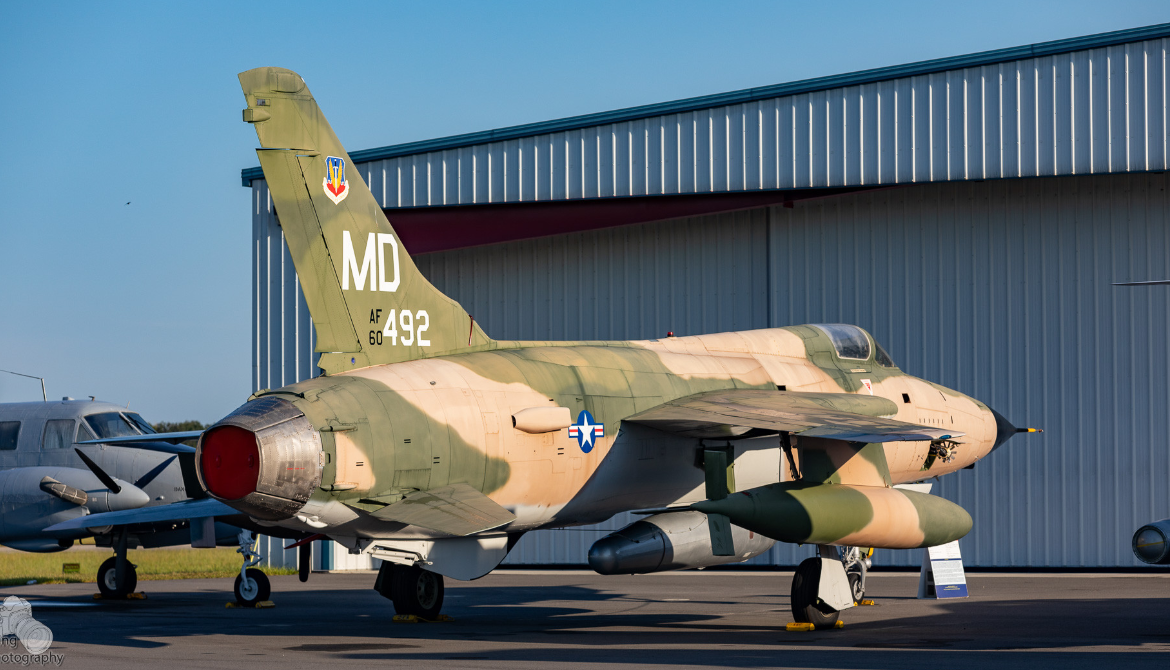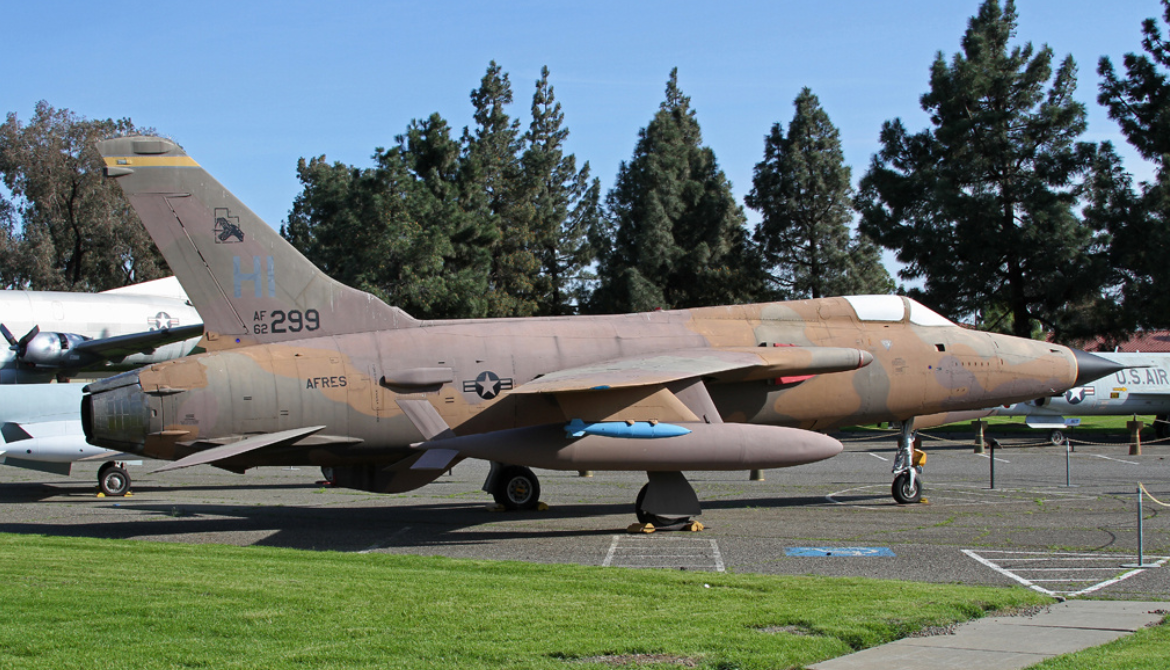F-105 Thunderchief
"the Thud"
 |
|
| General information | |
|---|---|
| Type | Fighter-bomber |
National origin United States
Manufacturer Republic Aviation
First flight 22 October 1955
Introduction 27 May 1958
Retired 25 February 1984
Primary user United States Air Force
Produced 1955–1964
Number built 833
.
History Republic Aviation Corporation.
Republic F-105 Thunderchief "the Thud"
First Flight 22 October 1955
Introduction 27 May 1958

The Republic F-105 Thunderchief is an American fighter-bomber that served with the United States Air Force from 1958 to 1984. Capable of Mach 2, it conducted the majority of strike bombing missions during the early years of the Vietnam War; it was the only American aircraft to have been removed from combat due to high loss rates. It was originally designed as a single-seat, nuclear-attack aircraft; a two-seat Wild Weasel version was later developed for the specialized Suppression of Enemy Air Defenses (SEAD) role against surface-to-air missile sites. The F-105 was commonly known as the "Thud" by its crews.
As a follow-on to the Mach 1 capable North American F-100 Super Sabre, the F-105 was also armed with missiles and a rotary cannon; however, its design was tailored to high-speed low-altitude penetration carrying a single nuclear weapon internally. First flown in 1955, the Thunderchief entered service in 1958. The single-engine F-105 could deliver a bomb load greater than some American heavy bombers of World War II such as the Boeing B-17 Flying Fortress and Consolidated B-24 Liberator. The F-105 was one of the primary attack aircraft of the Vietnam War; over 20,000 Thunderchief sorties were flown, with 382 aircraft lost including 62 operational (non-combat) losses (out of the 833 produced). Although less agile than smaller MiG fighters, USAF F-105s were credited with 27.5 kills.
Design
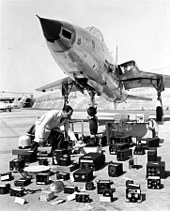
Front view of Republic F-105B with avionics layout The F-105 was a mid-wing monoplane with a 45° swept wing and tail surfaces. The single engine was fed by two intakes in the wing roots, leaving the nose free for a radome housing the multi-mode radar. Its fuselage provided room for 1,184 US gallons (4,480 L) of fuel and an internal bomb bay. The bomb bay measured 15 feet 10 inches (4.83 m) by 32 in (0.81 m) by 32 in (0.81 m); it was originally designed to carry a single nuclear weapon but typically held an additional 350 US gal (1,300 L) fuel tank. It featured four under-wing and one centerline pylon; the two inner wing and centerline pylons were capable of accepting fuel from 450 and 650 US gal (1,700 and 2,500 L) drop tanks. Two outer dry stations were wired for missiles or bombs. One M61 Vulcan (initially designated T-171E3) 20 mm 6-barrel Gatling-style cannon was installed in the left side of the nose. A short-range AIM-9 Sidewinder air-to-air missile could be carried on each of the outer wing pylons.
The F-105 was designed primarily for low-level interdiction and its low-altitude speed was its greatest asset when dealing with enemy fighters such as the MiG-17/J-5s and MiG-21. The F-105 managed 27.5 air-to-air victories. Based on combat experience, the F-105D was updated with a better ejection seat, additional armor, improved gun sights, and Electronic Counter Measures (ECM) pods on the wings.
0
KmCeiling
0
KmCombat RANGE
0
Km/hAircraft Speed
0
Max Crew
Photo Gallery
Republic Aviation Corporation.
Republic F-105 Thunderchief "the Thud"


Republic Aviation Corporation. Originally known as the Seversky Aircraft Company
Republic F-105 Thunderchief
General Info
-
-
- Crew: 1 (F-105F: 2[116])
- Length: 64 ft 4+3⁄4 in (19.628 m)
- Wingspan: 34 ft 11+1⁄4 in (10.649 m)
- Height: 19 ft 8 in (5.99 m)
- Wing area: 385 sq ft (35.8 m2)
-
Powerplant
-
- Empty weight: 26,855 lb (12,181 kg)
- Gross weight: 35,637 lb (16,165 kg)
- Max takeoff weight: (23,967 kg)
- Zero-lift drag coefficient: CD 0.0173
- Drag area: 6.65 sq ft (0.6 m2)
- Powerplant: 1 × Pratt & Whitney J75-P-19W afterburning turbojet engine, 14,300 lbf (64 kN) thrust 26,500 lbf (117.88 kN) with afterburning and water injection [
-
Performance
- Maximum speed: (1,390 mph, 2,240 km/h) / Mach 2.1 at (10,668 m)
- Combat range: (778 mi, 1,252 km)
- Ferry range: 1,917 nmi (2,206 mi, 3,550 km)
- Service ceiling: 48,500 ft (14,800 m)
- Rate of climb: 38,500 ft/min (196 m/s)
Armament
-
- Guns: 1 × 20 mm (0.787 in) M61A1 Vulcan 6-barreled Gatling cannon, 1,028 rounds
- Hardpoints: 5 total: 4 × under-wing, 1 × centerline pylon stations plus an internal bomb bay with a capacity of up to 14,000 lb (6,400 kg) of ordnance
Links to Youtube & Others
It was originally designed as a single-seat, nuclear-attack aircraft; a two-seat Wild Weasel version was later developed for the specialized Suppression of Enemy Air Defenses (SEAD).
Republic F-105 Thunderchief "the Thud"
Development of the type continue and in 1935 the Bf 108B appeared with the fin and rudder having undergone modifications.
Youtube Link
Conceived as a competitive aircraft the Bf 108 would take part in the 1936 Berlin Olympics.

